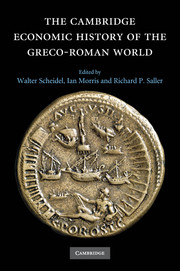Book contents
- Frontmatter
- 1 Introduction
- Part I Determinants of Economic Performance
- 2 Ecology
- 3 Demography
- 4 Household and Gender
- 5 Law and Economic Institutions
- 6 Technology
- Part II Early Mediterranean Economies and the Near East
- Part III Classical Greece
- Part IV The Hellenistic States
- Part V Early Italy and the Roman Republic
- Part VI The Early Roman Empire
- Part VII Regional Development in the Roman Empire
- Part VIII Epilogue
- Bibliography
- Index
- Map 1.1 The Mediterranean basin"
- Map 10.1 Greek and Phoenician trade in the period of the Persian Wars"
- Map 11.1 The Achaemenid empire"
- Map 12.1 Greece and Asia Minor"
- Map 15.1 The Seleucid empire"
- Map 16.1 Greco-Roman Egypt"
- Map 20.1 The Roman empire at the accession of Vespasian"
- References
2 - Ecology
from Part I - Determinants of Economic Performance
Published online by Cambridge University Press: 28 March 2008
- Frontmatter
- 1 Introduction
- Part I Determinants of Economic Performance
- 2 Ecology
- 3 Demography
- 4 Household and Gender
- 5 Law and Economic Institutions
- 6 Technology
- Part II Early Mediterranean Economies and the Near East
- Part III Classical Greece
- Part IV The Hellenistic States
- Part V Early Italy and the Roman Republic
- Part VI The Early Roman Empire
- Part VII Regional Development in the Roman Empire
- Part VIII Epilogue
- Bibliography
- Index
- Map 1.1 The Mediterranean basin"
- Map 10.1 Greek and Phoenician trade in the period of the Persian Wars"
- Map 11.1 The Achaemenid empire"
- Map 12.1 Greece and Asia Minor"
- Map 15.1 The Seleucid empire"
- Map 16.1 Greco-Roman Egypt"
- Map 20.1 The Roman empire at the accession of Vespasian"
- References
Summary
physical geography
The focus of the region of interest is the Mediterranean Sea, the world’s largest inland sea, about 3800 kilometers long. The Mediterranean Sea requires a constant influx of water from the Atlantic Ocean to maintain its level, since evaporation is much greater than the inflow from rivers. It has a low productivity and most parts of the Mediterranean coast have a very narrow continental shelf. These factors reduce the size of offshore fishing grounds and lead to small fish populations. The Mediterranean is relatively poor in fish. However the sea has always been extremely important for interregional contact because of the proximity of mountain ranges to a large part of the Mediterranean coastline, and also for access to the numerous islands in the sea.
The lands surrounding the Mediterranean Sea are more often than not hilly or mountainous. This is the result of intense tectonic activity and uplift caused principally by the interaction of the Eurasian and African plates, which are moving towards each other at the rate of about two centimeters per year. Mediterranean geology is largely based on limestone, which is easily eroded by the catastrophic floods and rainstorms that are characteristic of the Mediterranean climate, creating extremely uneven topographies. Large flat plains are rare in Mediterranean countries. A large number of rivers and streams descend from the uplands to the sea; the Nile is the only major river whose water supply originates almost entirely outside the vicinity of the Mediterranean basin. The water courses are fed by winter rainfall. Many of them gradually dry up during the summer, as do many of the wetlands in coastal regions.
Keywords
- Type
- Chapter
- Information
- The Cambridge Economic History of the Greco-Roman World , pp. 13 - 37Publisher: Cambridge University PressPrint publication year: 2007
References
- 11
- Cited by

